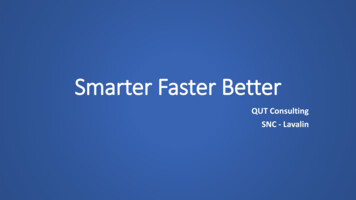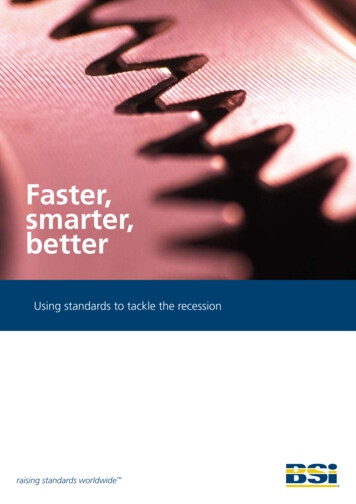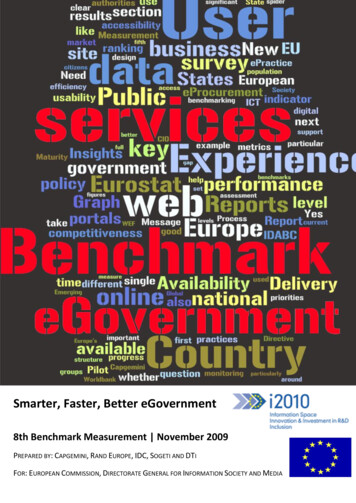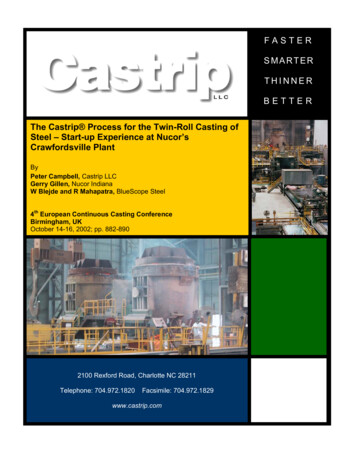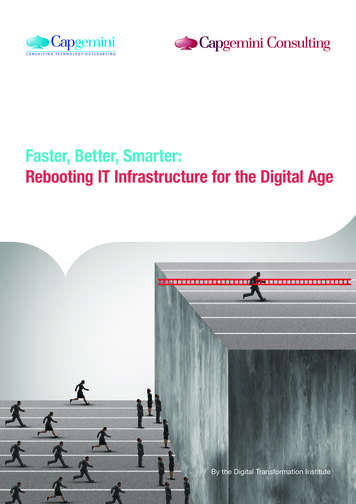
Transcription
Faster, Better, Smarter:Rebooting IT Infrastructure for the Digital AgeBy the Digital Transformation Institute1
Why IT’s Digital Transformation MattersNow More than EverOrganizations today succeed or fail depending on their ability to stay ahead of market and technologychanges. To do so, its IT infrastructure must support a seamless flow of data, global consistency andinteroperability, faster time to market, and on-demand analytics capabilities (see Figure 1).Figure 1: How digital platforms powered by IT infrastructure accelerate businessdigitizationSeamless flow of data250billionThe numberof rowsWalmart’sdata platformcan handleWalmart employs a data platformcapable of handling 250 billion rowsof data and updating 20 millionrecords an hour. 94% of its dataoperations take less than 2 seconds,allowing a near-real time peek intoSKU and store level data that helpmake proactive business decisions.Faster Time to MarketJawwy, a digital mobile operator inthe Kingdom of Saudi Arabia,partnered with cloud serviceproviders to deliver a fully digitalcustomer experience to a largelymillennial target segment. Theservice took just over a year frominception to launch.Global consistencyand interoperabilityVisa opened its payments platform tothird-parties and developers offeringimmediate interoperability with over13,700 financial institutions in 200 countries and over 40 millionmerchants around the world.On-demand analyticscapabilitiesSchindler optimizes the routes takenby its service technicians byproviding them instant access to dataanytime, anywhere, saving 40 millionkilometers of driving and prevented4,435 tons of emissions per year.Source: Capgemini analysis; SAP, “HANA powers Walmart’s Data Café”, March 2015; PYMNTS.com, “Visa OpensUp Network With Visa Developer Launch”, February 2016; MVNO Dynamics, “BRIEF: STC to launch new Jawwybrand”, May 2016; Apple.com, “Elevating service and safety with real-time data”, November 2015There is no doubt that IT infrastructure and operations (I&O), often referred to as the “run” side of IT, hasgraduated from a function that “keeps the lights on” to a driver of digital transformation in many organizations.However, its core transformation seems to have taken a backseat. I&O takes responsibility for running theorganization’s digital assets, such as data centers, cloud services, and communication networks. Andcompanies invest massive amounts in their IT infrastructure – over 70% of IT budgets and even up to 90%1,2.However, the largest chunk of investment is operational in nature – running and maintaining existing ITsystems. Very little – 15% of IT budgets3 – is assigned to transforming IT systems. In other words, modernizingIT hardware, networks and data systems to prepare these assets for the demands of the digital age andsupport key strategic priorities:2
Between1.25and 2.5billionUSDCost ofunplannedapplicationdowntime Cost efficiency: In our research, 55% ofexecutives believe that IT is expected to havea significant impact on cost reduction4. The baris also being raised by tech providers: AmazonWeb Services has cut its prices 50 times in thelast 9 years5. Performance: Entire value chains rely on IT.Applications are now the face of business, andthe customer experience relies on IT with anysystems downtime leading to lost business.Estimates suggest that unplanned applicationdowntime costs Fortune 1000 companiesbetween 1.25 and 2.5 billion each year6. Agility: Recent research shows that 60% ofdigital transformation initiatives will not be able toscale because they lack a strategic architecture7.In other words, the long-term view of how variousdepartments, infrastructure, and processes needto evolve to accomplish business objectives. Cybersecurity: As IT systems go global,new and hybrid infrastructures – such as opencollaboration via APIs – open organizationsto new risks. According to a study, just 7% ofcloud services meet security, compliance andgovernance requirements8.The digital enterprise requires digital ITOur 2015 research with the MIT Center for DigitalBusiness showed how digital enterprises seizeopportunities and respond to disruption muchmore quickly than traditional firms. They are fleeterof foot at establishing partnerships, responding tocustomers’ needs and preferences, and detectingemerging trends. To capitalize on these strengths,digital enterprises need be adept at buildingrelationships, highly adaptive operationally, andable to seize new business models (see Figure 2).IT needs to play a key role here: Stimulating new relationships: With internalusers and partners via digital workplaces Fueling new operations: Through automation,integration of siloed systems and agile workprocesses such as DevOps Powering new business models: By extractingvalue from data and cloud-based delivery modelsto enable utility-based “pay-per-use” servicesFigure 2: How must IT Infrastructure & Operations help organizations address evolvingbusiness prioritiesBUSINESSNew RelationsITNew OperationsInternal users& clientsPartners ISBusiness integrationAgile & DevOpsIndustrializationAutomationNew RelationsNew OperationsOrchestrationPay-per-useNew Business ModelsNew Business ModelsCustomersClientsPartnersThings ServicesAdaptativePrestissimoDemand drivenSocialCrowd mobilizationAPI economyProduct supportedservicesUmbilical cordsSource: Capgemini analysisIn the sections that follow, we explore how to make this IT transformation possible: The key pillars of I&O’s digital transformation Putting that digital transformation into practice A roadmap for the transformation journey3
The Key Pillars of IT’s Digital TransformationDigital enterprises require digital IT. Drawing on our research and experience of working with large, Fortune500 organizations across a range of industries, we believe that the digital transformation of IT must embracefour key pillars: Cloud Delivery Model, Digital Workplace, BI & Analytics Platform, and Digital DevOps Factory(see Figure 3).Figure 3: Key pillars of IT digital transformation and business objectives they fulfillCloud Delivery ModelFlexible and cost-effectiveinfrastructure; enable self-serviceand utility based modelsBI & Analytics PlatformDigital WorkplaceA centralized platform forreal time analysis of highvolume data scatteredacross different systemsBost employee satisfaction andproductivity; cultivate newrelations with customes, vendorsand partnersDigital DevOps FactoryFaster time to market for digitalproducts and serviceSource: Capgemini analysisPillar 1: Adopt a cloud delivery modelAddress data and infrastructure security concerns with the public cloudThe opportunities of the cloud – as outlined inFigure 4 – are balanced by the need to manageany risk around data and infrastructure security inthe public cloud. Organizations are beginning to bemore confident about the way public cloud serviceshandle security. Recent research suggests thatenterprise IT and security professionals no longercite security as the top challenge to public cloudadoption9. Public cloud providers have worked hardto address security concerns and to offer stateof-the-art protection against cybercrime. Dataencryption technologies are also advancing rapidly,allaying fears related to data breaches and thefts.The IT function must, however, protect apps hostedon public cloud, as some can be vulnerable as theirsecurity design is not robust enough. Leadingorganizations classify their applications into onesthat are and are not suitable for public cloud.Utilize a cloud orchestration platformCloud computing supports on-premise IT (mostlyprivate, under full IT control) and external platforms(mostly public, outside of IT control). The future ofcloud delivery will be a mix of public and private4cloud services from multiple cloud providers. Thechallenge, therefore, is to design a service modelthat orchestrates these two means of delivery.Research suggests that 82% of organizations
Figure 4: Key considerations for adopting a cloud delivery model98%Reduction ininfrastructurerelatedoutages at GEOil and Gasthanks to amigration tothe cloudMaximizing IT’s value to businessRobeco migrated its 220,000 retail banking clients to aSoftware-as-a-Service banking platform on cloud, leading to costsavings of up to 40% and becoming the first bank on cloud in the worldAddressing data and infrastructure security concernsCarefully assess security issues related to IT services as in many casesGoogle, Amazon and Microsoft services are found to be more securethan internal IT servicesAdopting acloud deliverymodelLeveraging a cloud orchestration platformA cloud orchestration platform is essential to deliver cloud serviceswith simplicity and ease of use amidst growing complexity of cloudlandscapeManaging non-technical nuances of cloud transformationWhen GE Oil and Gas migrated 261 applications to the cloud over acourse of 18 months – IT played a key role to bring together innovativecloud migration practices that proved essential for its successSource: Capgemini analysishave a hybrid cloud strategy in 2015, up from 74%in 201410. Integrating cloud services from differentproviders while considering security aspects, hybriddeployment and varying service levels is complex.This is where service orchestration comes intoplay. A cloud orchestration platform integrates andorganizes various cloud services into a one-stop,automated catalog of services for the entireorganization. Cloud services from different vendorsand cloud configurations plug into the orchestrationplatform, hiding the complexity and integrationissues from the business user. The end-user cansimply consume services such as access to servers,data storage and software development tools.Manage non-technical elementsThe success of a cloud transformation is based ona large amount of elements that are non-technicalin nature (as much as 70 to 80%). Examples arenew service catalogs, new competencies and newprocesses. Organizations must therefore avoid apurely technical approach. When GE Oil and Gasmigrated 261 applications to the cloud over acourse of 18 months, for example, IT also focusedon areas such as the right training to accelerateadoption. As a result of the program, infrastructurerelated outages fell by 98% percent and total costof ownership reduced by 52%11.5
Pillar 2: Establish a BI & Analytics PlatformAs Figure 5 shows, two of the key challenges in bigdata implementations are IT infrastructure issues:‘scattered data in silos’ and ‘legacy systems’. ITinfrastructure has a key role to play in establishinga BI and analytics platform that makes it possibleto connect data across the enterprise. This will beessential to meet the requirements of the growingamount of data scientists in organizations. Datascientists expect IT to provide ready-to-usecomputing power and storage capacity for their BigData use cases. I&O can support the data demandsof the enterprise through an enterprise-wide BI &analytics platform that can store and handle massiveamounts of structured and unstructured data in lowcost commodity storage (see Figure 6).Ingestion processes extract data from all availabledata sources and load them in a data lake (largescale, low-cost data storage). I&O also shoulder theresponsibility of providing business users with dataprocessing and analysis tools that work seamlesslywithout depending on legacy systems.Figure 5: Top challenges to big data implementationInfrastructure & operations has a direct impact on two out of four top big data challenges46%39%35%31%Scattered datalying in silosacross variousteamsAbsence of aclear businesscase for fundingIneffectivecoordination of BigData and Analyticsteams across theorganizationDependency onlegacy systems fordata processingand managementSource: Capgemini Consulting, “Cracking the Data Conundrum: How Successful Companies Make Big DataOperational”, January 2015; Capgemini Analysis6
Figure 6: How a BI & analytics platform helps firms better leverage their data assetsData ScientistUsageBusiness onRestitutionUsageBusinessStructurationI&O provides calculation servers to business for installingtheir Usage and Structuration toolsStructurationConnectorsITData LakeSmart DataStorage & CPUBig data storage & CPU and ingestion architectureIngestionTraditional BIdatawarehouseor MasterdatabasesExternal Data(social Data /Partner data)IOT(dedicated networkand securedgateway)Source: Capgemini Consulting, “IT: From Boring to Sexy – Enable Your Business Digitization”, 20167
Pillar 3: Industrialize DevOpsThe advantages of DevOps adoption are wellestablished – increased agility and stabilitycontributing to improved innovation and increasedmarket share13. However, our research points toconfusion among I&O leaders because a standarddefinition and approach to implementing DevOpsis lacking14. We believe these challenges can beovercome with a carefully planned approach toindustrialize DevOps across the organizationand by fostering a culture of collaborationbetween development, operations and businessprofessionals.Follow a Digital DevOps Factory framework for a successful DevOps initiativeOrganizations must abandon the traditional mindsetthat development teams (Dev) add new featuresand operations (Ops) teams endeavor to keep ITsystems stable and working smoothly. Bringingthe two teams together in a DevOps environmentdramatically reduces deployment risk and timeto-market. A Digital DevOps Factory framework(see Figure 7) puts more focus on collaboration,new organization processes, fail fast/learn fast andcreative skills. The framework propels a DevOpsprogram by preparing it for: A new generation of automation tools:Segregate the ownership of tools deploymentand management between Dev and Ops, withDev taking the lead on app lifecycle tools and Opson deployment & execution platforms (PaaS) andInfrastructure Services (IaaS). Capabilities to develop within theorganization: This involves building new skillsfor both Dev and Ops but also newer ways ofworking, such as a new culture of collaboration.Instead of failure being forbidden, DevOps teamsfocus on their ability to react in the event of afailure and learn from mistakes.Figure 7: Leverage the Digital DevOps Factory framework to structure the launch ofa DevOps programCapabilities todevelop within theorganization1App Life CycleAutomationDigital factorycomponents to buildand integrateTools with Dev as leadVersion control / Continuousintegration / Test framework2Deployment & Execution PlatformBuild staging / prod environments(data, OS, app configs)Manages Microservices deploymenton VMs or Containers and APIsInfrastructure Services (IAAS)3Source: Capgemini analysis8Manages infra provisioing through APIsEnables infrastructure as code(highest level of automation)Tools with Ops as lead
Figure 8: The DevOps Maturity Model to Help Organizations Achieve theirDevOps VisionLevel 5: Top LevelOne team dynamic process near-instant deployment of changes no dev-related outagesLevel 4: EnhancedCo-authoring of solutions one lifecycle no manual process end-to-end managed environmentsLevel 3: Co-ordinatedJoint and shared objectives dev2ops connected lifecycle limited manual processes lowrelease duration & significantly reduced outagesLevel 2: EmergingEmergence of joint teams starting to establish connected processes some automation &isolated tools medium release duration & reduced outagesLevel 1: BasicTraditional siloed organization separate processes separate tools with many manual activitiestypically very long release duration and high outagesSource: The Open Group, “IT4IT Agile Scenario - Using the Reference Architecture”, February 2016Define a clear target and transformation plan for DevOps implementationCapgemini, a Platinum Member of the Open Group– a global consortium for proposing IT standards– recently realized a paper in association withthe group to help enterprises get best resultsfrom DevOps15. It advocates that the DevOpsimplementation must start with defining a cleartarget and creating a strong business case. Thisenables organizations to carefully select projectsand environments that are most likely to benefitfrom DevOps. It also proposes a maturity model thatcan help IT leaders to effectively plan and evolveDevOps implementations (see Figure 8).9
Pillar 4: Launch a digital workplaceThe digitization of the workplace is crucial for bothemployee satisfaction and areas such as employeeproductivity, efficiency and effectiveness. However,many companies have been struggling with theirdigital workplace initiatives. For example, only 15% ofNorth American and European information workersare satisfied with their companies’ understanding ofthe tools they require to be successful in their jobs12.15%Percentageof employeessatisfiedwith theircompany'sunderstandingof the toolsthey need10Getting it right can be a significant driver of efficiency.An energy service company was able to drasticallyimprove power plant maintenance processes byleveraging cloud-based workplace productivitytools (see Figure 9). Using root cause analysis byvideoconferencing, maintenance experts anywherein the organization can now remotely superviseon-site technician intervention, resulting in increasedresponsiveness and productivity.Schindler’s Digital Tool Case:An Empowering Digital WorkplaceSchindler’s Digital Tool Case – a collection of digital tools and services – serves as a one-stopdigital workplace for its 30,000 installation and service technicians. As a result of the DigitalTool Case, field-force technicians can: Optimize their service routes, saving the company 40 million kilometers of driving anderadicating 4,435 tons of emissions per year Access an inventory of over 40,000 spare parts and order them directly from customer site Access crucial on-the-job information such as technical manuals Collaborate with offsite experts via FaceTime to troubleshoot issues better and fasterSource: Apple.com, “Elevating service and safety with real-time data”, November 2015; CapgeminiConsulting, “Going Up @ Schindler: How the Elevator and Escalator Giant Rose to Digital Excellence”,September 2016
Figure 9: How digital workplace can disrupt business processes - Illustration1Receive an alertfrom a power plant2Analyze rootcausesof the incidentFast incident localization(incident located in site A)Meeting (video & audio)between engineers teamslocated in sites B and C toidentify root causes andlaunch the mitigation plan(issue is due to a technicalpart break down)Troubleshootthe issue on fieldScheduling on remote andon real time betweencentralized engineers teamsand on-site A technicians toexplain actionsChat on real time duringtroubleshooting processwith central engineers ifneededInventory of spare parts,Root cause analysis file,mitigation procedureuploaded in real timeEasiest interventions onfield based on uploadedpictures, videos of theincidents and on mitigationprocedure accessibleanytimeCo-edition of documentanalyzing incident rootcauses (each engineer cansuggest an hypothesis)PRODUCTIVITYTOOLFILE SHARINGwarehouse andrequest spare part4Nearest warehouselocalization with requiredspare partTRACKINGEMAIL, CONTACTSCALENDAR, INSTANTMESSAGING, VIDEO3 Localize nearestGathering of fieldinformtion (picture andvideos of the incident)directly uploaded on therepository for immediatetransmission to engineersMaintenance contracts,incidents review sheets insite A powerplantaccessible anytime on theirupdated versionSource: Capgemini analysis11
Putting digital IT transformationinto practiceIn our experience, leading enterprises organize their I&O departments into three distinct layers – businessinteraction, service integration and legacy & industrialized IT (see Figure 10). While organizational models willvary depending on their business context, each of these layers can support one or more of the four key pillars.Figure 10: Infrastructure & Operations organizationDev TeamsEnd Users Data ScientistLegacyCore systemAn effectiveBusinessInteractionlayer movesIT from acost centerto a businesspartner,focusedon clientsatisfaction,businessvalue andclientrelationships.AgileDirectNew digital servicesIAMEx: Workplace and Big DataSECURITYSOC 4.0Client service delivery managementCloudDigitalWorkplaceBI & AnalyticsInnovation &offeringsService Integration layerLegacy & Industrialized IT layerSource: Capgemini analysisFormalize a Business Interaction layer to maximize customer satisfactionAn effective Business Interaction layer moves IT froma cost center to a business partner, focused on clientsatisfaction, business value and client relationships.This organizational layer delivers services to clientsin a multimodal manner in three areas: Legacy, in a classical water fall Agile methodologies, eg, new digital services Directly with the business, eg, workplaces andBig Data12The concept of organizing into dual-speed IT of (1)Legacy and (2) digital/agile is now well understood.Leading organizations, however, also use the directmode, where you interact directly with businessstakeholders, without any mediation from internalsilos. This mode is ideal for projects such asdigital workplaces or big data applications or anysubjects that are new or require specific attention.When a subject reaches maturity, activities can betransferred to the Legacy & Industrialized IT layerfor industrialization.
Establish a Service Integration layer to bring a step change in service qualityMost organizations source IT infrastructure frommultiple vendors, benefiting from the reduceddirect costs. However, this creates a complicatednetwork of multiple technology vendors. While eachsupplies a portion of infrastructure that works wellin isolation, that portion does not necessarily workwell with other systems. Organizations often end upcreating infrastructure silos, affecting the quality ofIT services and customer satisfaction.An effective service integration layer allowsthe enterprise to enjoy the benefits of sourcinginfrastructure from multiple vendors, drawingtogether multiple technologies to ensure even themost complex needs are met. A general serviceintegration layer acts as a buffer, tying the underlyingtechnical and vendor specific aspects togetherand presenting a single view of IT operations tothe Business Interaction layer. A service integrationlayer also helps organizations prioritize their ITinvestments by providing better visibility of ITsystems.Service integration activities represent between 15%and 30% of IT workload. Our experience showsthat service integration activities can be regroupedin various proportions. For instance, with one ofour clients, we were able to demonstrate that afull regrouping can translate into as much as 40%in savings within the teams involved around thosetopics (which usually represent around 50% of totalIT services staff).Harvest cost efficiencies through a Legacy & Industrialization layerBest-in-class IT operations are organized bytowers, such as storage, network or private/publiccloud that specialize in technical domains. Thisenables I&O to deliver cost-effective, industrializedoperations where experts can focus on their specificdomain (see Figure 11). Each tower oversees thefull spectrum of activities, ranging from high-valueprojects that are delivered internally to lower-valuerun activities that are outsourced. These outsourcedrun activities must have effective governance, suchas setting up an operational committee with theoutsourcing partner to manage transitions.Figure 11: Leading firms specialize and segregate their legacy & industrialization teamsinto towersStandalone ServersCloud emPrivatePublicNetworksSupport(on-site, L1)Source: Capgemini analysis13
A Roadmap for the TransformationDigitizing IT is more than a technology challenge– it requires transformation of organization,culture, people and process. With peoplecosts representing around 50% of I&O costs,neglecting these elements would undermine thetransformation effort.Drive an integrated transformationThe transformation program needs to includetechnical foundations, innovation drivers and culturalchange (see Figure 12):one of the largest mobile network providersglobally, extensively digitized its IT organization.IT consolidated IT infrastructure spread acrossmultiple countries at a massive scale – removingnearly 2000 legacy systems over two years,closing a legacy datacenter every month16,and moving aggressively to cloud and virtual Transform infrastructure: Build the technicalfoundations that allow you to leverage thetechnology fundamentals: agility, performance,cost-efficiency and cybersecurity. Telefonica,Figure 12: Infrastructure & Operations organizationTRANSFORMthe infrastructure2000The numberof legacysystemsTelefonicaremoved overtwo yearsTRANSFORMthe organizationOptimize sourcingImplement virtualization andautomation enablersMove to cloud: SaaS / IaaS / PaaSdepending on applications landscpeassessmentImplement orchestration andbrokerage enablersINDUSTRIALIZEdelivery modelDefine target operating andorganizational modelsReinforce factories & COEs,leveraging near offshoreDefine associated savingsroadmap and incentive directorsRun / Build separationDefine IT for IT roadmapGuarantee service continuity andsecurityImplement Service Integrationroles, tools and structureProfessionalize projectmanagementDeploy learn methodologies tosimplify processOptimize technical tools: DCtwinning, capping etcLeverage new ways of working,new ways of managementSet up a digital architecture: microservices, API, IoTImplement key business use cases:digital workplace, big databrokerage platform, digital devopsfactoryImplement a business centricsecurity (SOC)Upskill people or recruit talentsrequired by shift in expertise andprofiles (service owner, programdirector etc.)Implement multimodal ITDrive cultural change: measure ofperformance and business partner.Make innovation happenInnovation Labs to funnel POCsSet up of internal communitiesOverall transformation managementInnovation process and governanceGlobal target build (IT & the business)Source: Capgemini analysis14Dedicated time in each teams to test and experiment
infrastructure. These efforts have played theirpart in Telefonica reducing its debt burden by 14billion and returning to revenue growth despite atroubled economic outlook17. Industrialize the delivery model: Reviewyour sourcing policy to outsource commodityrun activities, expand your center of excellencefootprint, and refocus key internal resources onbusiness-differentiating activities. Transform your organization: Benefittingfrom a cloud delivery model depends onorganizational transformation. Start by designinga target organizational model, then drill downto processes, tools, and ways of workingand managing.Secure funding and support with a strategy for savings and quick-winsOur research with the MIT Sloan Management Reviewrevealed that lack of funding is the second biggestorganizational barrier to digital transformation18.Leading I&O organizations redirect cost savingsfrom enhanced operations to finance transformationprojects (see Figure 13). BBVA, a leading global bankbased in Spain, shifted its technology investmentsfrom operational to transformational spend, whiledoubling its technology investment from 1.2 billionin 2006 to 2.4 billion in 2013. BBVA Chairman &CEO Francisco González said: “A substantial changetook place in the proportion of funds spent to keepsystems operational (“run”) to funds invested innew development (“change”), moving from theindustry standard of 80%/20% to a new standardof 60%/40%.”19At the same time, I&O must secure a few early-winsto gain support for the wider transformation, bysetting up shared service centers and developingstrategic sourcing. Automation can also deliver asmuch as 80% savings in IT personnel costs. RoboticProcess Automation provides cognitive computingsystems that are highly applicable for runningoperations such as service desks or operationsmonitoring, such as security monitoring.Figure 13: Reallocation of Savings from Operational Improvements towardsTransformationSAVE.TO REINVESTTransformTransformRunRunConclusion: Next-Generation IT InfrastructureIT&O leaders have always faced a difficult task:meeting the needs of the business while at thesame time being expected to keep a lid on costs.Today, the needs of the business are changingfundamentally. Today’s digitally-driven enterpriserequires IT that allows executives to harvest insightfrom big data, drive operational effectivenessthrough mobility, and meet the ever-changingrequirements of today’s digital customers. Byengaging deeply with the business – and driving acore transformation of IT – I&O leaders can deliverthe intelligent technologies that support profitablegrowth in today’s digital economy.This paper is an abridged version of the report: “IT: From Boring to Sexy – Enable Your BusinessDigitization” published by Capgemini Consulting. For a full version of the report, please urce-file-access/resource/pdf/from boring to sexy.pdf15
How Digital are your IT Infrastructure &Operations?This assessment can help you understand where your I&O organization stands on the journey to becomingdigital. The questionnaire has 20 questions to assess the digital maturity of the I&O organization acrossfour categories – overcoming organizational barriers, setting I&O priorities, adopting a new delivery modeland roadmap for I&O transformation.How to use this assessment:1. For each statement, assign a score between 1 and 6 for your organization2. Calculate the total score by adding up the scores for individual statements3. Compare your overall score with the legend provided at the end of the survey to understand your I&Oorganization’s digital maturity4. Categories which obtain lower scores than others require more attention to speed up I&O
Faster, Better, Smarter: Rebooting IT Infrastructure for the Digital Age By the Digital Transformation Institute. 2 Organizations today succeed or fail depending on their ability to stay ahead of market and technology changes. To do so, its IT infrastructure mus
